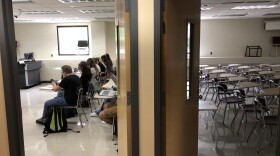In 2005, long-lost letters from the famed Pabst and Best families, written from 1841 to 1887, were found at Pabst Farms in Oconomowoc. Once discovered, they were moved to the basement of the Pabst Mansion in Milwaukee and the content of those letters wouldn’t be known until 15 years later.
These letters were written in an old German script last used in the 1940s. Translating and transcribing the letters needed the skills of UWM’s Translation and Interpreting Studies program — one of only three schools in the country with a graduate program for German to English translation. A partnership was formed between the program and the Pabst Mansion in the spring of 2020, and graduate students Nastassja Myer and Marisa Irwin tackled the challenge.
“[The letters] were written in this old German handwriting style, it’s called ‘Kurrentschrift’ and it was last used in 1941. So, most people, even native Germans do not know how to read this today,” Irwin explains.
Irwin and Myer say that historical translation, especially of personal communication like these letters, requires more than just learning to read Kurrentschrift. The letters reference family members, business competitors and events happening at the time. So, both Myer and Irwin had to spend time digging through historical archives to try and get a better understand of these relationships to inform their translation.
“Historical translation in general, you add on this whole layer of historical research that you need to do in archives, in parallel document sources because you’re trying to get the language of the time right,” says Irwin.

Myer says her favorite letter to translate was by a woman named Ana Gaertner, who is thought to be a good friend of Maria Best — the matriarch of the Best family. She says that Gaertner wrote with erratic punctuation and an abundance of exclamation marks and that her personality really came through in the single letter.
“That was actually pretty fun to translate because I had to figure out, 'How do I show this enthusiasm? How do I make a convincing translation of this woman’s personality in this letter?'” says Myer.
Milwaukee is known for its long German heritage and Irwin says these letters help show a time in Milwaukee’s history when people could spend their entire life in the city and only use the German language.
“Seeing the amount of German that was used and that you could survive and be in the elite society speaking German was really incredible,” says Irwin.
According to Myer, getting to be part of the team that help translate this important part of city history made all of the hard work worth it.
“[My work] was really making an impact on the understanding of the history of Milwaukee and of Germans in America and so it felt very important, and I was very pleased and honored to be part of it,” says Myer.
The work is not over though, there are still over 300 documents in the collection that need to be translated and the Translation and Interpreting Studies program is hoping with the help of new graduate students over the next few years that they can complete the translation of the entire collection.







